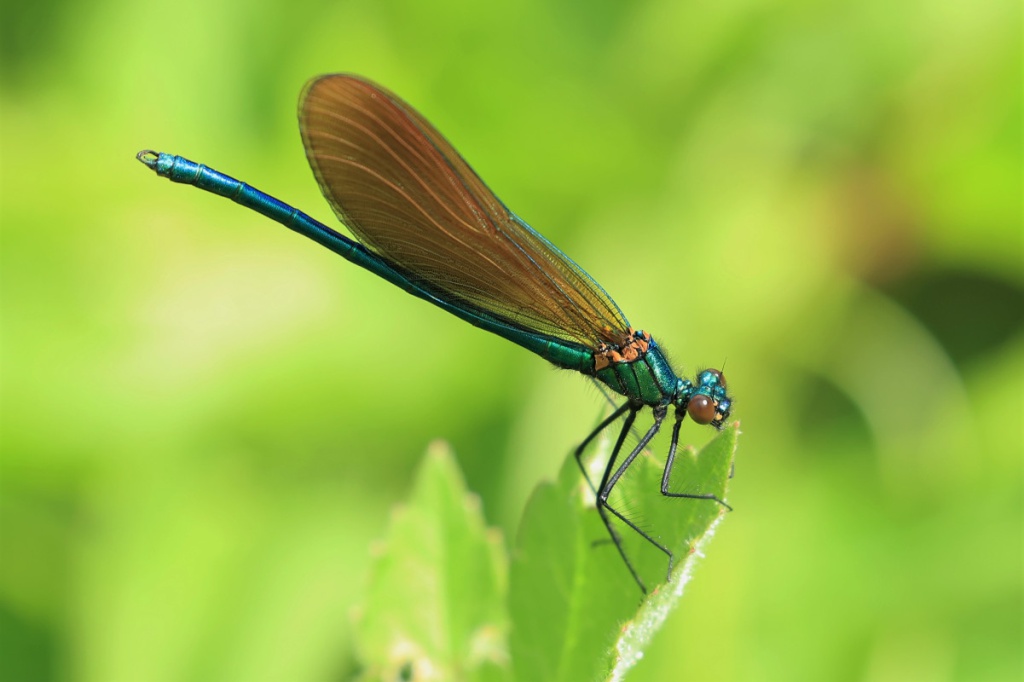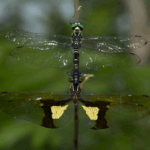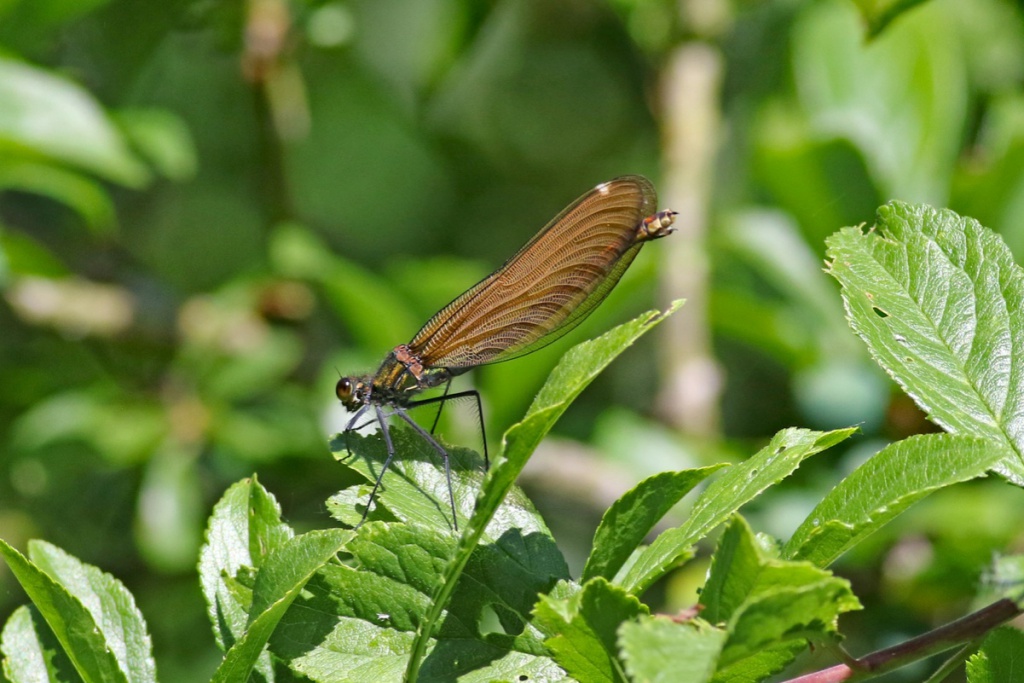
The beautiful demoiselle (Calopteryx virgo) is a species of damselfly belonging to the family Calopterygidae. It is found in Europe, North Africa, and Western Asia. It is often found along fast-flowing waters.
Large metallic damselfly with fluttering, butterfly-like wings.
Male: metallic blue body with dark wings.
Female: metallic green-bronze body with translucent pale brown wings.
Status & Distribution:Found in both Britain; the bulk of the population is spread across Wales, south-west England. There are a few scattered populations in northern England and western Scotland.
Habitat:Mainly found along streams and rivers, particularly those with sand or gravel bottoms. The males rest on bank side vegetation waiting for females.
Adult Identification:
- Length: 45mm
- Male: metallic blue body with dark wings.
- Female: metallic green-bronze body with translucent pale brown wings.
Larval Information:
Demoiselle larvae have long bodies, short spikey caudal llamellae and long ‘horn-like’ antennae.
Prominant ‘occipital tooth’ behind each eye.
Single pale band on the caudal lamellae.
Only Banded Demoiselle are similar in appearance.
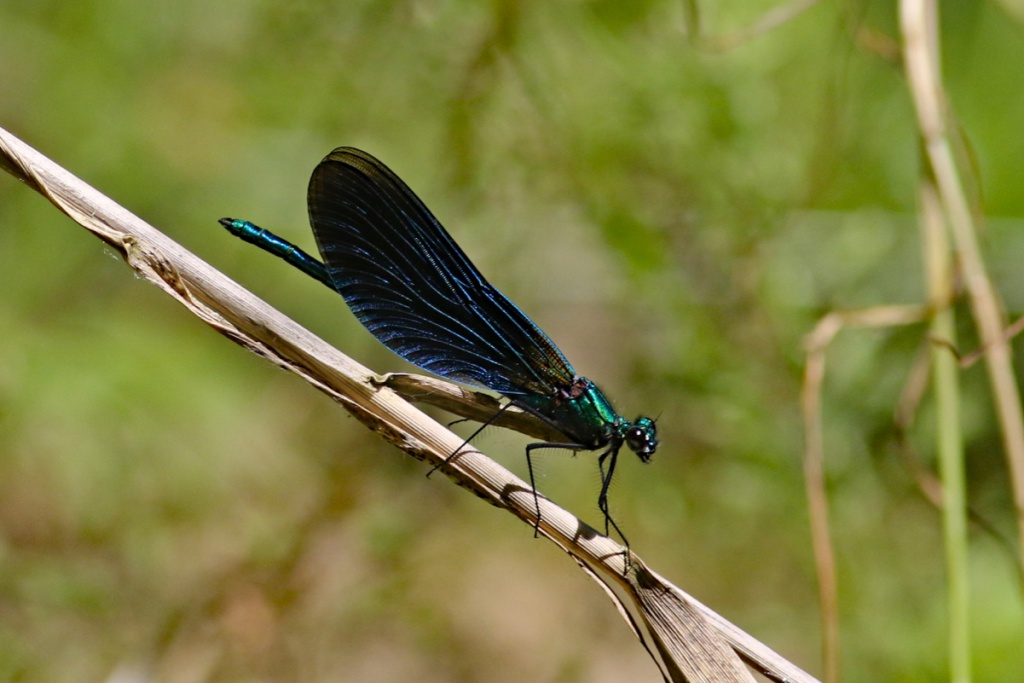
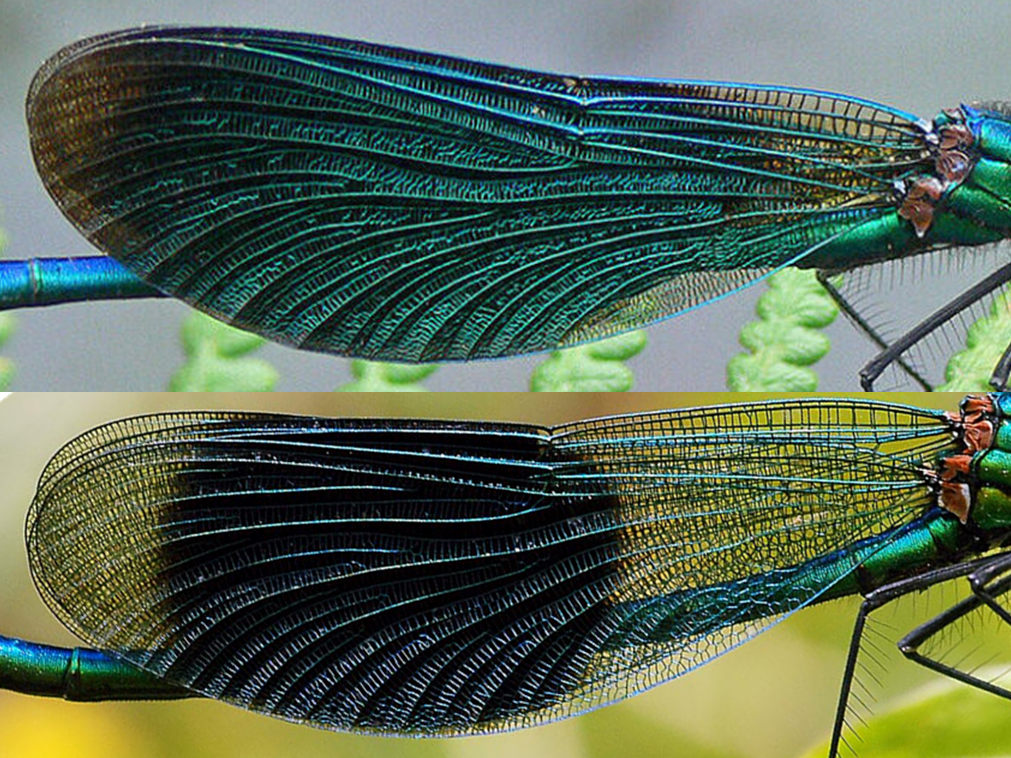
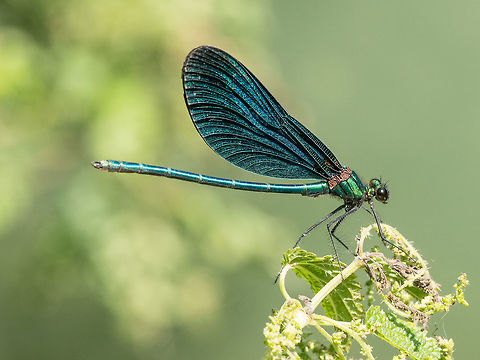
About
The beautiful demoiselle may look like a dragonfly, but it is in fact a large damselfly. The males are metallic blue and the females green. They live on small, fast flowing rivers in the west of the UK. They can be seen flitting and fluttering over head as the male tries to attract a female with its impressive dance moves!
How to identify
Male Beautiful demoiselles have dark-coloured wings and metallic blue-green bodies; females have brown wings and green bodies. The Beautiful demoiselle is similar to the Banded Demoiselle, but the males of the latter species have distinctive dark patches in the middle of their wings.
How people can help
The Wildlife Trusts manage many wetland nature reserves for the benefit of the wildlife they support. You can help by supporting your local Trust and becoming a member; you’ll find out about exciting wildlife news, events on your doorstep and volunteering opportunities, and will be helping local wildlife along the way. Encourage dragonflies and damselflies into your garden by having a wildlife-friendly pond. To find out more about gardening for wildlife, visit our Wild About Gardens website: a joint initiative with the RHS, there’s plenty of facts and tips to get you started.
Description
Eggs and larvae
Females can lay up to 300 eggs at a time on floating plants, such as water-crowfoot. Like the banded demoiselle, they often submerge underwater to do so, and the eggs hatch around 14 days later. The larvae are stick-shaped and have long legs. They develop over a period of two years in submerged vegetation, plant debris, or roots. They usually overwinter in mud or slime.
The larvae of the beautiful demoiselle develop over 10 to 12 stages, each of which ends with a moult. The body length varies and depends on environmental conditions. In the final stage (F-0-stage), larvae are 3.5–4.6 millimetres long and weigh about 4 milligrams, slightly smaller than those of the banded demoiselle. The larvae of the beautiful demoiselle can be recognized by the bristles of the gills on their abdomen.
The body of the larvae shows only a relatively small adjustment to the fast-flowing waters of their habitat. The body is not flattened, but it is very slim, and the legs are long and end with strong claws. Because they reside within the water, and mainly in quiet areas, the danger of being swept by the flow is relatively low. If this happens, they stretch out to grab onto passing vegetation or substrate.
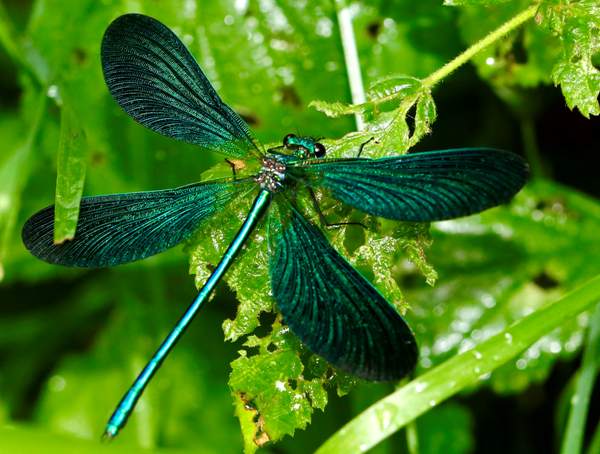
Adult
Beautiful demoiselle can reach a body length of 49–54 millimetres (1.9–2.1 in), with a hindwing length of 31–37 millimetres (1.2–1.5 in). These large, dark damselflies have small, lateral, hemispherical eyes; two pairs of wings similar in shape; and a slender abdomen. The wings have a dense internal network of veins, and can be transparent or uniformly colored at their basal area. This species presents an evident sexual dimorphism in colour pattern.
The male usually has much more extensive pigmentation on the wings than other Calopteryx species in its range. In the southeast of its range (the Balkans and Turkey), the wings are entirely metallic blue. In other areas, the wings have clear spots at the base and the tip. Immature males have brown wings, as the metallic blue wing color develops only with age. They have metallic blue-green bodies and blue-green eyes. The female has dark brown iridescent wings, a white patch near the tip of the wings (called a pseudopterostigma) and a metallic green body with a bronze tip of the abdomen.
This species is similar to the banded demoiselle (Calopteryx splendens), another British damselfly with coloured wings.
Habitat
Biotope
Beautiful demoiselles live mainly near small to medium-sized streams and creeks.[7] They prefer a relatively low water temperature and a moderate to fast flow. The water must not be nutrient-rich (eutrophic). In the northern part of their range, such as in Norway and Finland, they are also found near medium-sized rivers or even larger streams. The waters are usually in the immediate vicinity of forests.
Larval habitat
The larvae live in streams, and are mainly dependent on the water plants. The larvae need the stems and leaves to hold on to, especially in areas with strong currents. Because of this, it is extremely rare to find them in barren locations, flat expiring banks, or areas with a smooth stone floor. They also live in small natural lakes or ponds with limestone bedrock. They live in quiet areas between alluvial leaves or exposed roots. They can be found on submerged plants such as waterweed (Elodea sp.), water crowfoot (Ranunculus fluitans), or other plants submerged between a few centimetres to several decimetres.
Compared with the larvae of the banded demoiselle, the larvae of the beautiful demoiselle prefer quieter areas of the water, since slower flows allow for a more effective absorption of oxygen underwater. Only in very rare cases are the larvae present in stagnant water. The larvae reside mainly in vegetation.
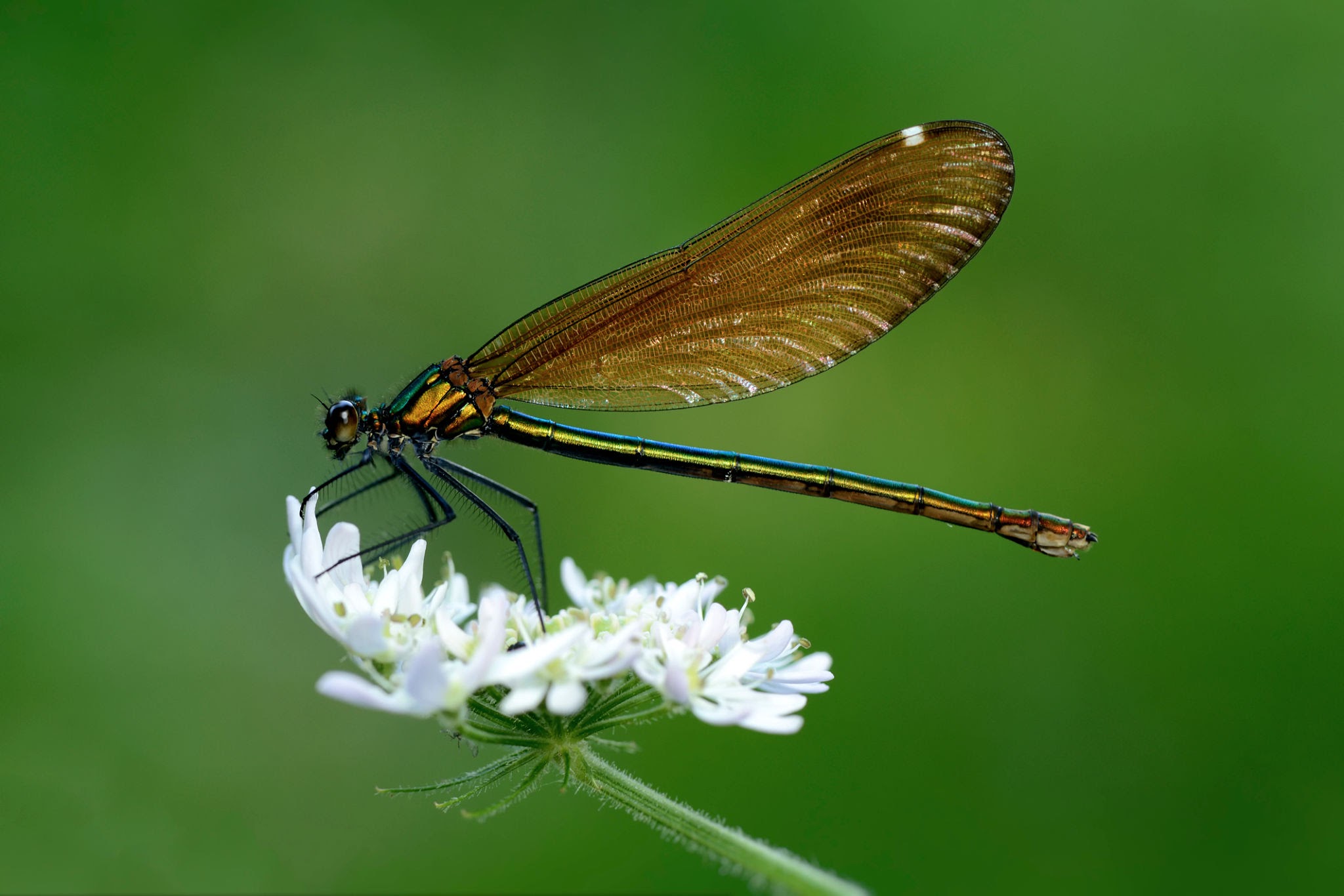
An important factor in the occurrence of beautiful demoiselles is the oxygen in the water. The larvae are much more sensitive to oxygen deficiency than the larvae of the banded demoiselle, and need sufficient oxygen saturation in the water. Waters with high levels of sediment and sludge are not a good habitat for the larvae.
Another key factor for the occurrence of the larvae of the beautiful demoiselle is the temperature of the water. This species prefers cooler, shadier areas of the water, with an optimal summer average temperature between 13 and 18 °C. At temperatures above 22 °C, injuries to larvae were observed, as well as a reduced hatchability of eggs. Individual populations may adapt to permanently higher temperatures.
Adult habitat
The habitat of adults corresponds to the nearby larval habitat. Unlike the adults of the banded demoiselle, beautiful demoiselle may be found in forest clearings, and very rarely on the banks of larger ponds. Trees and shrubs are used as resting places, with the beautiful demoiselle often resting on high herbaceous plants such as the large nettle (Urtica dioica).
The breeding habitats are similar to the larval habitat. They prefer cool, shady waterways, with a more or less strong current, and near-natural vegetation and bank structure. This tends to be meadow and pasture streams in the area, and rarely forest. Riparian vegetation also plays a role as a windbreak. Due to their broad wings, the beautiful demoiselle can be blown away by the wind more easily than other species of damselflies.
Description and identification: The beautiful demoiselle is a type of damselfly. It has a wing span of around 6cm, and four wings which it holds in a closed position when at rest. The two sexes are different in appearance: the males have a metallic blue-green body and dark-coloured wings, whilst the females have a green body and brown wings. The related banded demoiselle is similar but the male has a large spot on the wing instead of solid pigmentation and the female has green wings.
Habitat: This species inhabits fast-flowing streams and rivers, with fine sand or gravel substrates, which are often shady with over-hanging vegetation.
Diet: Like all dragonflies and damselflies, the larvae of the beautiful demoiselle are voracious predators, eating anything they can catch! The adults are also predators, catching flying insects on the wing, which they hunt using their excellent eyesight.
Ecology and reproduction: This is one of only three dragonfly and damselfly species in Britain to exhibit true courtship behaviour: the male attracts a female and entices her to mate with his fluttering display flight. Eggs are laid on vegetation within the watercourse and take 14 days to hatch. The larvae remain in the water for two years. When a larva is fully grown it will climb out of the water on a piece of vegetation, and slowly emerge from its larval skin, which can take several hours and leaves the animal vulnerable to predation. The adults survive for only a few weeks. The best time to see them is between late May and late August.
Distribution: In the UK the beautiful demoiselle is found mainly in the south and west of England and in Wales. It is also found across most of Europe, in North Africa and parts of Asia. In Denbighshire it is known from fast-flowing streams and rivers around the county.
Threats: The main threat facing this species is habitat loss, through changes in management of land and watercourses, development and pollution.
Status: This species is not protected by law and is not currently a priority for conservation action since is it sufficiently common and widespread. Work being undertaken to clean up and improve the quality of our rivers and streams, such as the Environment Agency’s Water Framework Directive programme, will benefit this and many other species across the UK.

